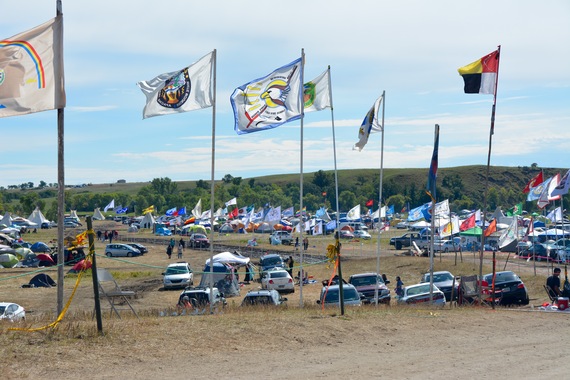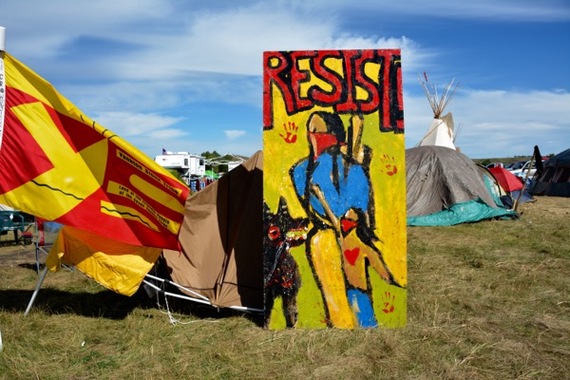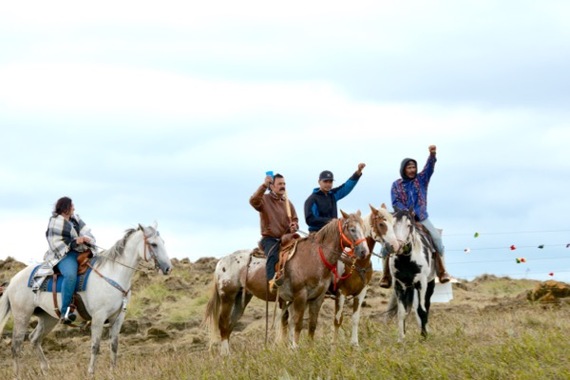120 Indian Nations and 5,000 people rejoiced on Friday, September 9 when the Department of Justice, the Department of the Army and the Department of the Interior rejected Federal Judge James Boasberg's 58-page dismissal of the Standing Rock Sioux Tribe's request for an injunction against the U.S. Army Corps of Engineers. At issue is a federal permit for Energy Transfer Inc.'s $3.8 billion Dakota Access Pipeline (DAPL). The Tribe argued that USACE failed to conduct proper environmental and cultural impact studies and that the proposed pipeline would cross under a section of the Missouri River that serves as a source of water for the tribe. That is the simple summary, but the issues run tragically deep for the Sioux Nation and span hundreds of years of lies and broken treaties.
DAPL is calculated to move over a half-billion gallons of crude oil daily across four states. The oil would enter the pipeline in the Bakken shale fields of North Dakota, cross South Dakota and Iowa, and end in Patoka, Illinois. Winona LaDuke, founder of the environmental organization Honor the Earth, calls it a "pipeline from nowhere." The Bakken boomtowns are ghost towns since oil prices plunged, and LaDuke says the pipeline is a bet that oil will rebound to $60 a barrel.
No Artifacts, No Graves, No Problem
Energy Transfer made a very bad calculation when, less than a week before the rulings, it took court documents showing the exact locations of historic graves, including stone representation of the constellations, and brazenly used them as a map to identify and destroy cultural sites. Graves of ancestral chiefs essential to tribal history and beliefs were scattered and buried under eight feet of earth in some places. They are irretrievable.
In an interview with Democracy NOW, Jan Hasselman, Earthjustice attorney for the Sioux Nation, described how Energy Transfer decided to literally bury the evidence of cultural artifacts and graves.
...We filed this evidence with the court Friday afternoon [September 2] in order to support our claim that there should be a timeout on construction until some of these legal issues can get resolved. We were stunned and shocked to hear that they took that information and, Saturday morning, over a holiday weekend, went out and bulldozed the entire site. We have a sworn declaration from one of the tribe's cultural experts that describes some of these sites, multiple gravesites and burials, very important archaeological features of the kind that are not found commonly. And we put all that in front of the court. And the next morning, it was gone.
North Dakota's Bloody Saturday
Shocked by the desecration of graves, peaceful protestors who had been camping in prayer at the Sacred Stones Camp near the Standing Rock Reservation, confronted the bulldozers. Women and children were pepper sprayed and bitten by attack dogs. Agents hired by the pipeline interests are currently being investigated by the North Dakota licensing board to determine if the "security forces" were licensed and "if the use of force was appropriate."
The State had to respond in some manner, since social media exploded with images of snarling dogs with foaming bloody mouths chasing woman and children. Memes quickly propagated with pictures of 1965's Bloody Sunday in Selma Alabama side by side with the DAPL attack dogs. North Dakota now has its "Bloody Saturday," but given the egregious nature of the attacks by pipeline interests, the licensing board inquiry rings hollow.
On Saturday September 10, Morton County issued an arrest warrant for Democracy Now's Amy Goodman. Goodman's footage of the attack on protestors is a graphic account of what happened on bloody Saturday, and remains as the best record of what took place. It seems journalism is now also illegal in North Dakota. In a taciturn response on Twitter, Goodman said, "This is an unacceptable violation of freedom of the press. I was doing my job." Indeed.
In addition, the Governor of North Dakota has militarized the situation by calling out the National Guard to replace local law enforcement presence at a barricade on Highway 1806. The imposing and uniformed presence is a "traffic information point," but it is functioning as a profiling and arrest point for Native Americans. (As an aside, I sailed through the Guard checkpoint, but was detained at another checkpoint on Highway 6 because I had firewood in the back of my car. Being white does not necessarily protect you if you are carrying press credentials (or wood)).
The arrest and charging of Cody Hall, a leader of the neighboring Red Warrior camp, is a flashpoint of anger and frustration for protestors. Hall was arrested Friday afternoon at a checkpoint after police stopped him in a vehicle with expired tabs. He is charged with criminal trespass during the "Bloody Saturday" protests on September 3.
Casting an even wider net, Morton County authorities also issued arrest warrants for Green Party presidential candidate Jill Stein and her running mate Ajamu Baraka. The two are also charged for criminal trespass.
That is where the situation stands today, but the prayerful fight is far from over. It is important to understand that prayer was the universal response at the Camp of the Sacred Stones, even after the attacks by security personnel. Prayer and spirit are important components of Lakota culture.
Reading the Docket Tea Leaves
In order to understand the thinking of the Federal Court, it is necessary to plow through all 58 pages of Judge Boasberg's opinion. On the first page, Boasberg sums up the Court's thinking.
Domestic oil pipelines, unlike natural-gas pipelines, require no general approval from the federal government. In fact, DAPL needs almost no federal permitting of any kind because 99% of its route traverses private land.
Therein lies the rub.
Is the "private land" where the ancestors were buried before the bulldozers came really private, or does it belong to the Sioux Nation by treaty? In an ironic twist, before the signing of the 1868 Fort Laramie Treaty, "Wicasa Wakan Tatanka Iyotake" (Sitting Bull) and 50 Oceti Sakowin (Great Sioux Nation Chiefs) gathered beneath a huge open tipi at Standing Rock to discuss persecution and other U.S. government policies.
Today there is a "United Nations" of 120 Nations in almost the same spot as Sitting Bull's encampment. For an excellent interactive account of shamefully broken treaties by the United States, see Ernestine Chasing Hawk's series online.
Gabriel S. Galanda, the managing lawyer of Galanda Broadman, PLLC, in Seattle, says, "It is my hope that the #NoDAPL narrative begins to include the fact that these are reserved ancestral Sioux Treaty lands and waters."
Those sacred lands and the sacred lands astride the Missouri River in rightful dispute, are reserved ancestral Sioux Treaty territory. The 1868 Treaty of Ft. Laramie reserves ancestral lands "commencing on the east bank of the Missouri river where the 46th parallel of north latitude crosses the same, thence along low-water mark down said east bank..." Without getting into the technicalities of any Sioux Treaty land diminishment vis-a-vis the 1851 Ft. Laramie Treaty, the Standing Rock Sioux Reservation sits along the west bank of the Missouri River, as does the Camp.
"How then can there not be a legitimate claim to protect the water that runs through reserved ancestral Sioux Treaty territory---water that has demarcated the eastern Treaty boundary for 150 years---water that has run through Sioux lands since time immemorial?"
Is Judge Boasberg fluent in Treaty History?
Caution and Vigilance Required
Within an hour after Judge Boasberg's ruling, the Department of Justice, the Department of the Army and the Department of the Interior overturned the Judge's decision.
The Army will not authorize constructing the Dakota Access pipeline on Corps land bordering or under Lake Oahe until it can determine whether it will need to reconsider any of its previous decisions regarding the Lake Oahe site under the National Environmental Policy Act (NEPA) or other federal laws. Therefore, construction of the pipeline on Army Corps land bordering or under Lake Oahe will not go forward at this time.
But did it really stop construction of the pipeline, or is this a tactic to delay and calm tensions?
The language is riddled with loopholes denying DAPL access on "Corps land" bordering or under Lake Oahe "until it can determine whether it will need to reconsider any of its previous decisions." The agencies cite a "need for discussion," including tribal input "within existing statutory framework."
According to Judge Boasberg, the "statutory framework" requires that the pipeline move forward.
This language from DOJ is hardly a ringing endorsement of the Sioux Nation's claim for environmental protection and historical preservation.
Then there is expert testimony filed seeking an injunction from further construction by DAPL.
Thomas F. King, Ph.D., an anthropologist from the University of California, Riverside, has fifty years' experience working with the National Historic Preservation Act (NHPA), the National Environmental Policy Act (NEPA) and related federal laws and regulations, as well as with American Indian tribes, Native Hawaiian organizations, and other indigenous and minority groups.
King is concerned and the Sioux Nation should be too.
The Corps, however, persisted and continues to persist in considering not the full range of effects of it permitted projects, but only those effects that fall under its regulatory control. Indeed, today I find the Corps deeply resistant to considering any effect that the applicant for its permit does not itself identify and report to be significant.
Cause for Skepticism and Getting to Yes
A day after the temporary reprieve from the Federal Government, The Sacred Stone Camp released the following statement,
We have seen time and time again, a consistent strategy from the State in these situations: string out the process, break it to us gradually to avoid a big confrontation, present the illusion of careful, thoughtful review of the case, tempt us with promises of modest reforms...but then in the end make the same decision that serves money not people. So far this is just talk, not actions, and actions are all we should care about. Stop the pipeline, and then we'll celebrate. We are not leaving until this is over.
by Wakíƞyaƞ Waánataƞ (Matt Remle- Lakota) Source: lastrealindians.com
Camp leaders have a valid point. No one wants to negate the relief and exhilaration the Sacred Stone Camp is experiencing, but the continuing military presence offers a cautionary tale. Why is the Governor of North Dakota using the National Guard to protect Energy Transfer, Inc. and the Canadian corporation Enbridge? Why the continuing warrants? Why the blockades?
This hardly seems to be a neutral ground for negotiation.
Responding to the call for caution from camp leaders, Winona LaDuke told Canadian television, "The consultation process has been abysmal."
"Consultation does not just mean getting to yes for a pipeline company. Actually, sometimes no means no."
Along Came a Reporter from Laos
It is quite possible that a question from an unknown Malaysian female journalist in Laos was the genesis for the sudden and unexpected intervention by the Obama administration. It seems that people a half a world away from Standing Rock knew more about the protests at Standing Rock than the President did.
In an interview broadcast on CSPAN President Obama was asked specifically about the DAPL just two days before Judge Boasberg's scheduled ruling. The location was a press conference in Laos. The reporter specifically asked Obama if he stood in solidarity with indigenous people in North Dakota and how he could ensure protection of ancestral lands.
Obama stalled for almost two minutes before admitting that he did not know about the pipeline and referred to his staff for more information. He probably knew he was caught.
After all, just two years ago he stood at Standing Rock in an election year and promised support to the poverty stricken reservation.
"My administration is determined to partner with tribes," Obama said. "It takes place every day on just about every issue that touches your lives."
Another broken promise.
The administration seems to have missed two years of discussion and heartache. Obama cannot get away with stopping the Keystone XL to great praise while replacing it with another that follows almost the same routing.
During my visits to Standing Rock over the last two weeks, I have witnessed too many tears and much anxiety. I was told many times by elders and young people alike that perhaps the events of Bloody Saturday were the Creator's design. Sometimes great tragedy is the predicator of needed reform. I think of Hurricane Katrina and the resulting great flood of New Orleans that exposed the shameless practices of the USACE.
I tend to agree with Camp leaders that much caution is needed during this time of celebration. We have tricked Native Americans time and time again, leaving them with flooded lands as rivers were dammed, a landscape devoid of wildlife and trees, and a crushing poverty.
Carefully read the words in the latest rulings and documents. Intent is written there.
(Still Photos by Georgianne Nienaber)




